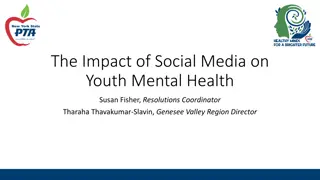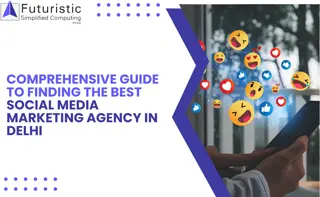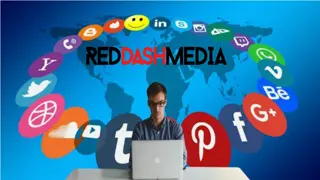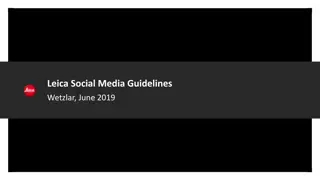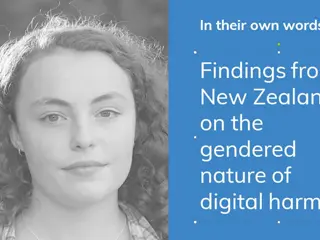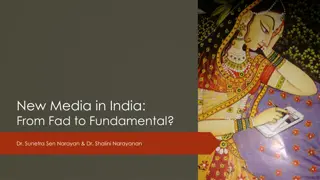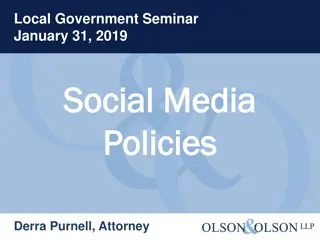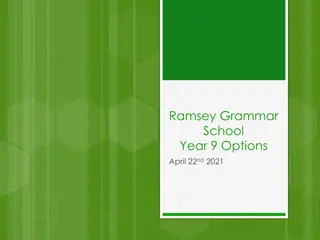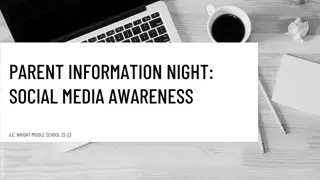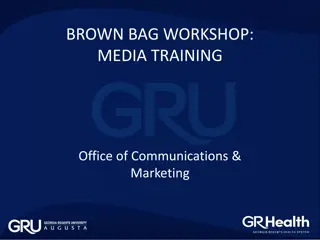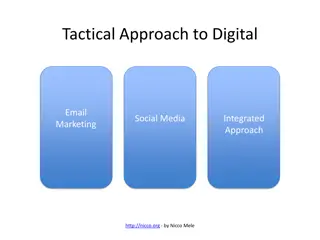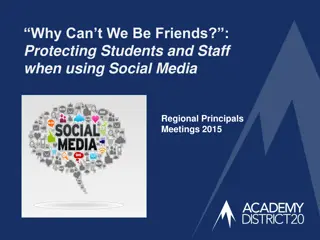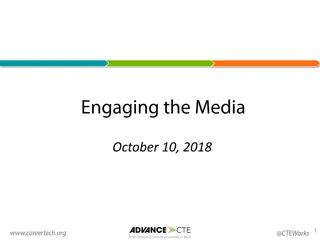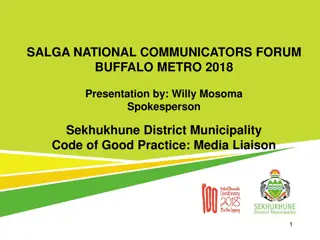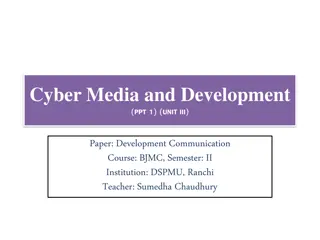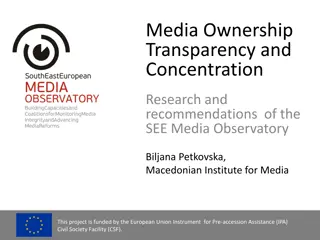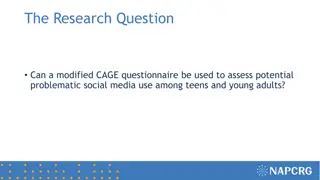The Importance of Social Media and Online Safety for Children
With the increasing exposure of children to social media and the internet, it is crucial to understand the risks they face and how to ensure their safety online. This content discusses the impact of social media on young people, reasons for its widespread use, risks such as cyberbullying and exposure to inappropriate content, and the importance of parental involvement and supervision in addressing these concerns.
Download Presentation

Please find below an Image/Link to download the presentation.
The content on the website is provided AS IS for your information and personal use only. It may not be sold, licensed, or shared on other websites without obtaining consent from the author. Download presentation by click this link. If you encounter any issues during the download, it is possible that the publisher has removed the file from their server.
E N D
Presentation Transcript
Social Media and Online Safety
Why is this important? 43% of our pupils have their own mobile phone with access to internet 30% of these pupils are in P1-3 Almost daily situations in school where online behaviours have carried over into school setting Lack of understanding/fear of change
Social Media What is Social Media? Social media are interactive technologies that facilitate the creation and sharing of information, ideas, interests, and other forms of expression through virtual communities and networks. Users usually access social media services through web-based apps on desktops or download services that offer social media functionality to their mobile devices.
Why is there so much Social Media use by young people? increasing numbers of single working parent and dual-working parent households and after school programs that eat into play and socialisation time of the kids. The lack of time for face-to-face socialisation is compounded by practical issues such as the pandemic, and parental restrictions that stem from fears of predators, drug dealers and gangs. Changes in society along with the advent of Internet and its various applications, have resulted in the emergence of an unrestricted social life in a virtual setting. As parents we scrutinise who our children interact with in the real world but what controls do we have in the virtual world? The increased presence of youth online has raised serious concerns about the safety of Internet and social media use. Difficulty in self-regulation, lack of awareness of repercussions of privacy compromise and susceptibility to peer pressure are listed as reasons for teenagers' cavalier attitude towards online risks such as sexting, cyberbullying and exposure to inappropriate content as they navigate social media.
The risks of Internet and social media to children is just as real as the risks in society. Cyberbullying, in the forms of name-calling and gossiping, spreading rumours, making threats or otherwise sending malicious messages through emails, message boards and social media, has augmented offline bullying and estimates of the incidence of cyber bullying range from 23 to 72% in various studies. Exposure to age-inappropriate content is another serious risk because it causes much damage to an age-group that is already prone to sexual uncertainty and uncommitted and possibly unsafe sexual exploration. Dangerous communities that support self-harm activities, such as anorexia, drug use, and such other disruptive concepts are also serious pitfalls of unsupervised Internet usage among teens.
Legal age for accessing Social Media The reason most social media services use an age limit of 13 or over is in part because of a law in the USA. The COPPA law or Children s Online Privacy Protection Act states that any organisations or people operating online services (including social media services) are not allowed to collect the personal information of anyone under the age of 13 without parental permission.
Guidance for age of use of apps Tik-Tok, Snapchat and Instagram 13+ Twitter (X), Discord and Twitch 17+ Facebook, Whatsapp 13+ The Children's Code came into effect in September 2021 requiring all online platforms that could be accessed by UK under-18s to legally follow several key data principles preventing them from negatively impacting children s privacy. This includes accounts for under-16s that must now be set to private by default, have geo-location disabled, and all privacy-related information presented in a way that children can understand.
There are a number of health issues that may develop as a result of too much time online. Depression Anxiety Sleep deprivation Envy Communication issues
Some positives for social media use Promotes creativity Fosters purposeful mindfulness Connecting with peers with similar interests Promote awareness Promotes critical thinking
GroupMe GroupMe is an app that doesn't charge fees or have limits for direct and group messages. Users also can send photos, videos, and calendar links. What parents need to know? It has adult themes. The embedded GIFs and emojis have some adult themes, such as drinking and sex. Teens are always connected. Without fees or limits, teens can share and text to their heart's content, which may mean they rarely put the phone down.
Kik Messenger Kik Messenger is an app that lets kids text for free. It's fast and has no message limits, character limits, or fees if you only use the basic features. Because it's an app, the texts won't show up on your kid's phone's messaging service, and you're not charged for them (beyond standard data rates). What parents need to know? Stranger danger is an issue. Kik allows communication with strangers who share their Kik usernames to find people to chat with. It's loaded with covert marketing. Kik specializes in "promoted chats" -- basically, conversations between brands and users. It also offers specially designed apps (accessible only through the main app), many of which offer products for sale.
Whatsapp Whatsapp lets users send text messages, audio messages, videos, and photos to one or many people with no message limits or fees. What parents need to know? It's for users 16 and over. Lots of younger teens seem to be using the app, but this age minimum has been set by WhatsApp. It can be pushy. After you sign up, it automatically connects you to all the people in your address book who also are using WhatsApp. It also encourages you to add friends who haven't signed up yet.
Discord Discord started as a place for gamers to chat while playing video games but has become a bigger platform where users can use text, voice-chat, and video-chat to discuss a wide variety of topics. What parents need to know? There are public and private "servers" or discussion groups. Teens can join public groups, ask to join private ones, or start their own. The safest option is for them to join a private group with people they know in real life. Some groups are more moderated than others, some have warnings of inappropriate content, and some are hate-filled. There are plenty of groups that are meant for adults only, and some are totally tame and well moderated. If your child is in one of the latter, the risk is much lower.
Instagram Instagram lets users snap, edit, and share photos and 15-second videos, either publicly or within a private network of followers. It unites the most popular features of social media sites: sharing, seeing, and commenting on photos. It also lets you apply fun filters and effects to your photos, making them look high-quality and artistic. What parents need to know? Children are on the lookout for "likes." Similar to the way they use Facebook, children may measure the "success" of their photos -- even their self-worth -- by the number of likes or comments they receive. Posting a photo or video can be problematic if children are posting to validate their popularity. Public photos are the default. Photos and videos shared on Instagram are public unless privacy settings are adjusted. Hashtags and location information can make photos even more visible to communities beyond a teen's followers if his or her account is public. Kids can send private messages. Instagram Direct is like texting with photos or videos and you can do it with up to 15 mutual friends. These pictures don't show up on their public feeds. Although there's nothing wrong with group chats, kids may be more likely to share inappropriate content with their inner circles.
Tik Tok Tik Tok Real Short Videos is a performance- and video-sharing social network that mostly features teens lip-synching to famous songs but also includes some original song writing and singing. Users can build up a following among friends or share posts publicly. What parents need to know? Songs and videos contain lots of questionable content. Because the platform features popular music and a mix of teen and adult users, swearing and sexual content are commonplace. There are often creepy comments. Though lots of comments are kind, videos often have comments about the performer's body or other sexual references, and since kids under 13 and adults use the app, it's especially creepy. Gaining followers and fans feels important. Teens want a public profile to get exposure and approval, and many are highly motivated to get more followers and likes for their videos.
Snapchat Snapchat is a messaging app that lets users put a time limit on the pictures and videos they send before they disappear. Most teens use the app to share goofy or embarrassing photos without the risk of them going public. However, there are lots of opportunities to use it in other ways. What parents need to know? It's a myth that Snapchats go away forever. Data is data: Whenever an image is sent, it never truly goes away. (For example, the person on the receiving end can take a screenshot of the image before it disappears.) Snapchats can even be recovered. It can make sexting seem OK. The seemingly risk-free messaging might encourage users to share pictures containing sexy images. There's a lot of questionable clickbait content. Snapchat's Discover feature offers a grab-bag of articles, videos, and quizzes from magazine publishers, TV networks, and online sources mostly about pop culture, celebrities, and relationships (a typical headline: "THIS is What Sex Does To Your Brain").
Snapchat This is the app where most of our in school issues arise Group chats are created and children are left out disappearing chats are sent sometimes being nasty about others Threats are made and screenshots are taken
Sharing Images Sharing photos and videos online can be a great way to express yourself. Lots of people like to share selfies with friends - to show them what they re up to, express how they feel, or just to have a laugh. Some young people post naked or semi-naked (nude) images of themselves too. This might be because: They want to send one to a boyfriend/girlfriend They feel like they should send one to a boyfriend/girlfriend They want to flirt with someone they like They want to make their friends laugh They are being pressured to send one by someone else Whatever the reason, there are always risks involved in sharing naked pictures, particularly if someone isn t sending it because they want to. Once an image has been shared, there s a chance that it could be shared with more people.
Practical tips to help minimise the risks your child might face It s good practice for apps and websites to have safety advice and well- designed safety features which can make a real difference to how safe your child will be when using them. Work through safety and privacy features on the apps that your child is using, or might use. Make sure they understand the point of these and how to use them. Don t be put off by believing your child knows more than you: the tools are actually quite easy to manage. Ask them to show you which social media apps they use and what they like about them. Talk about how they use them and what makes them so engaging Explain how you can use privacy settings to make sure only approved friends can see posts & images Check if any of their apps have geo-location enabled, sharing their location unintentionally
Show them how to report offensive comments or block people who upset them Check tagging settings so that when others are posting or sharing photos online, your child s identity is not revealed. Also, get people s consent before sharing photos Encourage your child to come and talk to you if they see anything that upsets them
What are we at Riverbank doing to support pupils? NSPCC Online Safety resources Relationships, Sexual Health and Parenting resources PATHS Lessons Liaising with Community Police/Campus Cop at Eastbank Academy Liaising with families to respond to needs and support where possible
Child Protection and Safeguarding Keeping children safe and protected from harm continues to be our priority in school Mr Hynes is the Child Protection Coordinator, Mrs Whyte is the Depute Child Protection Coordinator All safeguarding concerns are reported to Mr Hynes. Once considered then a referral to Health and Social Care partnership may be required if there are Child Protection concerns
Further Support Think you Know: An education programme for advice about staying safe when you're on a phone, tablet or computer. www.thinkuknow.co.uk Home Activity Packs: Download home activity packs with simple 15-minute activities for your child to support their online safety at a time when they will be spending more time online at home. www.thinkuknow.co.uk/parents/Support-tools/home-activity-worksheets Internet Matters: Get expert support and practical tips to help children benefit from connected technology and the internet safely and smartly. www.internetmatters.org Project Evolve: Resources to equip children and young people for digital life. www.projectevolve.co.uk UK Safer Internet Centre: Promote the safe and responsible use of technology for young people and provide online safety tips, advice and resources to help children and young people stay safe online. www.saferinternet.org.uk
Further Support Childline: Childline is a free and confidential service for children and young people. You can phone them on 0800 11 11 or you can visit their website www.childline.org.uk NSPCC: If you are an adult and worried about a child you can call the 24-hour NSPCC helpline on 0808 800 5000 or visit their website. www.nspcc.org.uk ParentLine Scotland: Call 08000282233 or email: parentlinescotland@children1st.org.uk Parent Line's opening hours are from 9am-10pm (Mon-Fri) and 12 noon-8pm at weekends. Crimestoppers: Call 0800 555 111 or visit their website www.crimestoppers-uk.org Fearless: Fearless is a service that allows you to pass on information about crime 100% anonymously. This means you don't have to give us any personal details Police Scotland: Call 101 for advice and support (or call 999 if you think a child is in immediate danger). www.scotland.police.uk Internet Watch Foundation: Report remove nude images shared online.

 undefined
undefined
















